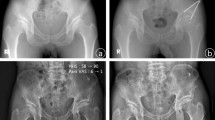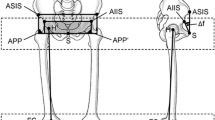Abstract
We retrospectively evaluated 17 hips in 16 patients who underwent a periacetabular osteotomy for the treatment of dysplastic hip with Perthes-like deformities. These residual deformities were graded using the Stulberg classification system. There were three class II hips, 11 class III hips and three class IV hips preoperatively. The average age of the patients at surgery was 36.9 years and the average follow-up was 6.6 years. The average Harris hip score significantly improved from the preoperative value of 68.2 points to 91.1 points postoperatively. The average postoperative range of motion in all directions did not change significantly from the preoperative value. The average postoperative Harris hip score of class IV hips was smaller than that of the class II or class III hips. The standard radiographic evaluations also showed significant improvements postoperatively. Periacetabular osteotomy without combined femoral osteotomies, as a treatment for patients with Perthes-like deformities, produced good clinical and radiographic results.
Résumé
Nous avons évalué de façon rétrospective 17 hanches chez 16 patients qui ont bénéficié d’une ostéotomie périacétabulaire pour le traitement de hanche dysplasiques avec des déformations de type Perthes. Les déformations résiduelles ont été classées selon la méthode de Stulberg. Il y avait en préopératoire 3 hanches de type II, 11 de type III et 3 de type IV. L’âge moyen des patients au moment de l’intervention était de 36.9 ans et le suivi moyen de 6.6 ans. Le score moyen de Harris a été amélioré de façon significative passant de 68.2 points à 91.1 points en post opératoire. La mobilité post opératoire n’a pas été affectée de façon significative par rapport à la mobilité préopératoire. Le score de Harris moyen post opératoire des hanches de type IV est légèrement inférieur à ceux de type II ou III. Les radiographies standards ont montré une amélioration significative en post opératoire. L’ostéotomie périacétabulaire sans qu’elle soit associée à une ostéotomie fémorale est un traitement qui donne donne de bons résultats tant sur le plan clinique que radiographique sur des hanches déformées de type Perthes.



Similar content being viewed by others
References
Cohen J (1971) Congenital dislocation of the hip. Case report of an unusual complication and unusual treatment. J Bone Joint Surg Am 53:1007–1011
Ezoe M, Naito M, Asayama I (2006) Muscle strength improves after abductor-sparing periacetabular osteotomy. Clin Orthop Relat Res 444:161–168
Ganz R, Klaue K, Vinh TS, Mast JW (1988) A new periacetabular ostetomy for the treatment of hip dysplasias: technique and preliminary results. Clin Orthop Relat Res 232:26–36
Harris WH (1969) Traumatic arthritis of the hip after dislocation and acetabular fractures: treatment by mold arthroplasty. An end-result study using a new method of result evaluation. J Bone Joint Surg Am 51:737–755
Heyman CH, Herndon CH (1950) Legg-Perthes disease; a method for the measurement of the roentgenographic result. J Bone Joint Surg Am 32:767–778
Massie WK, Howorth MB (1950) Congenital dislocation of the hip. Part I. Method of grading results. J Bone Joint Surg Am 32:519–532
Mayo KA, Trumble SJ, Mast JW (1999) Results of periacetabular osteotomy in patients with previous surgery for hip dysplasia. Clin Orthop Relat Res 363:73–80
Murphy S, Deshmukh R (2002) Periacetabular osteotomy: preoperative radiographic predictors of outcome. Clin Orthop Relat Res 405:168–174
Naito M, Shiramizu K, Akiyoshi Y, Ezoe M, Nakamura Y (2005) Curved periacetabular osteotomy for treatment of dysplastic hip. Clin Orthop Relat Res 433:129–135
Nakamura Y, Naito M, Akiyoshi Y, Shitama T (2007) Acetabular cysts heal after successful periacetabular osteotomy. Clin Orthop Relat Res 454:120–126
Nunley RM, Clohisy JC, Schoenecker PL (2007) Periacetabular osteotomy for the treatment of Perthes-like deformities of the hip. American Academy of Orthopaedic Surgeons (AAOS), pp 403 (abstract)
Stulberg SD, Cooperman DR, Wallensten R (1981) The natural history of Legg-Calvé-Perthes disease. J Bone Joint Surg Am 63:1095–1108
Tönnis D (1987) Congenital dysplasia and dislocation of the hip in children and adults. Springer-Verlag, New York, pp 165–171
Trousdale RT, Ekkernkamp A, Ganzy R, Wallrichs SL (1995) Periacetabular and intertrochanteric osteotomy for the treatment of osteoarthrosis in dysplastic hips. J Bone Joint Surg Am 77:73–85
Wiberg G (1939) Studies on dysplastic acetabula and congenital subluxation of the hip joint: with special reference to the complication of osteoarthritis. Acta Chir Scand 83(Suppl 58):1–135
Westin GW, Ilfeld FW, Provost J (1976) Total avascular necrosis of the capital femoral epiphysis in congenital dislocated hips. Clin Orthop Relat Res 119:93–98
Author information
Authors and Affiliations
Corresponding author
Rights and permissions
About this article
Cite this article
Shinoda, T., Naito, M., Nakamura, Y. et al. Periacetabular osteotomy for the treatment of dysplastic hip with Perthes-like deformities. International Orthopaedics (SICO 33, 71–75 (2009). https://doi.org/10.1007/s00264-007-0476-9
Received:
Revised:
Accepted:
Published:
Issue Date:
DOI: https://doi.org/10.1007/s00264-007-0476-9




